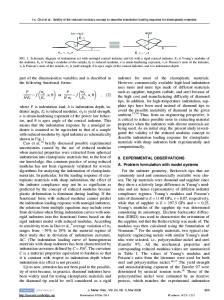Can indentation technique measure unique elastoplastic properties?
- PDF / 777,519 Bytes
- 17 Pages / 584.957 x 782.986 pts Page_size
- 45 Downloads / 399 Views
Nagahisa Ogasawara and Norimasa Chiba Department of Mechanical Engineering, National Defense Academy, Hashirimizu, Yokosuka 239, Japan
Xi Chena) Department of Civil Engineering and Engineering Mechanics, Columbia University, New York, New York 10027-6699 (Received 17 June 2008; accepted 7 October 2008)
Indentation is widely used to extract material elastoplastic properties from measured force-displacement curves. Many previous studies argued or implied that such a measurement is unique and the whole material stress-strain curve can be measured. Here we show that first, for a given indenter geometry, the indentation test cannot effectively probe material plastic behavior beyond a critical strain, and thus the solution of the reverse analysis of the indentation force-displacement curve is nonunique beyond such a critical strain. Secondly, even within the critical strain, pairs of mystical materials can exist that have essentially identical indentation responses (with differences below the resolution of published indentation techniques) even when the indenter angle is varied over a large range. Thus, fundamental elastoplastic behaviors, such as the yield stress and work hardening properties (functions), cannot be uniquely determined from the forcedisplacement curves of indentation analyses (including both plural sharp indentation and deep spherical indentation). Explicit algorithms of deriving the mystical materials are established, and we qualitatively correlate the sharp and spherical indentation analyses through the use of critical strain. The theoretical study in this paper addresses important questions of the application range, limitations, and uniqueness of the indentation test, as well as providing useful guidelines to properly use the indentation technique to measure material constitutive properties.
I. INTRODUCTION
Without losing generality, the elastoplastic properties of an engineering material are characterized by the elastic deformation at small strain, yielding at the onset of plastic deformation, and subsequent strain (work) hardening behaviors. The benchmark values of elastoplastic parameters, such as the Young’s modulus, E, yield stress, sY, and various hardening models (functions), are defined upon uniaxial loading, and thus in principle they should be measured from the uniaxial stress-strain (s-e) curves. The uniaxial tension/compression test, however, often involves significant effort in sample preparation, which is challenging for advanced materials and small material structures. As an alternative technique, instrumented indentation is widely used for probing the constitutive relationships of engineering materials including elastoplastic properties,1 and with easier sample preparation it
is especially suitable for small material structures.2–7 Note that sample preparation for indentation tests is typically easier compared to classical tension/compression tests. However, residual stress may be introduced during mechanical polishing, and such a problem may be alleviated using electrochemical po
Data Loading...











